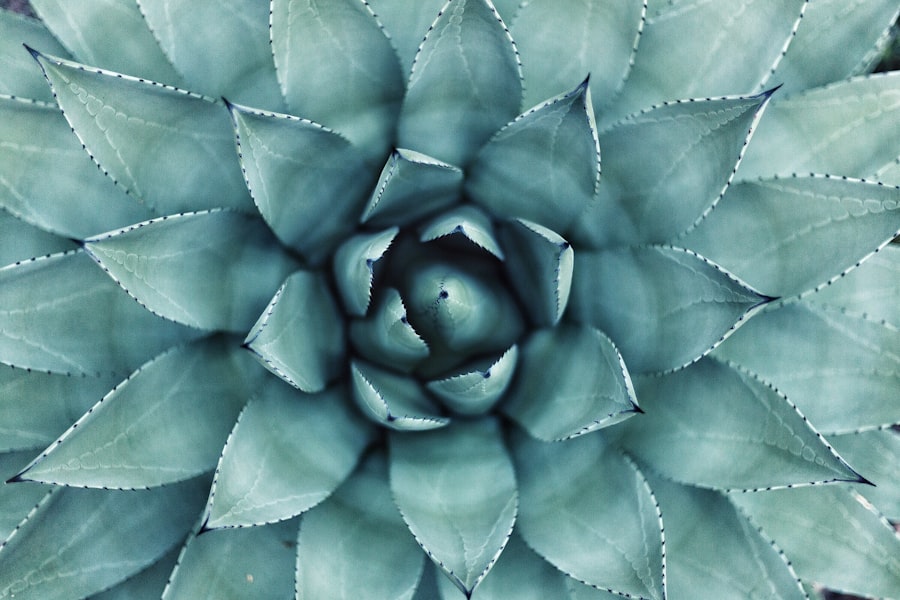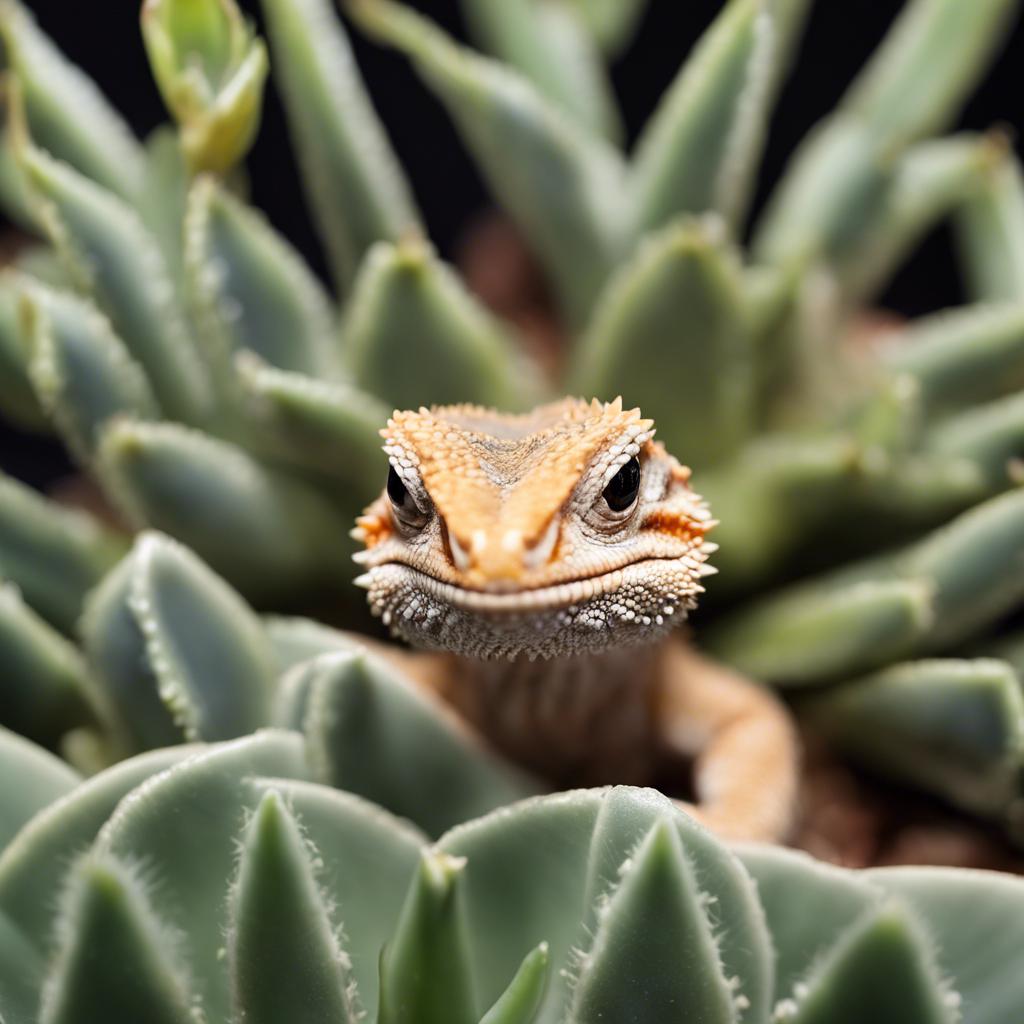Bearded dragons are popular reptile pets known for their unique appearance and docile nature. These reptiles are native to Australia and are often kept as pets due to their low maintenance requirements and friendly demeanor. On the other hand, succulents are a type of plant that store water in their leaves, stems, or roots, allowing them to survive in arid conditions. They have gained popularity in recent years due to their unique shapes and colors, as well as their ability to thrive in indoor environments with minimal care.
While bearded dragons and succulents may seem like an unlikely combination, many reptile enthusiasts enjoy keeping these plants in their terrariums as a way to create a natural and aesthetically pleasing environment for their pets. However, it is important to strike a balance between the care of the bearded dragon and the safety of the succulents. This article will explore the proper care for bearded dragons, common succulent varieties, the dangers of toxic succulents, symptoms of succulent poisoning in bearded dragons, treatment options for succulent poisoning, safe succulent alternatives for bearded dragons, precautions for keeping succulents around bearded dragons, and the importance of regular vet check-ups for these reptiles.
Key Takeaways
- Bearded dragons require a balanced diet and a suitable habitat for optimal health.
- Common succulent varieties can be toxic to bearded dragons and cause symptoms such as vomiting and lethargy.
- Symptoms of succulent poisoning in bearded dragons include loss of appetite, diarrhea, and seizures.
- Treating succulent poisoning in bearded dragons involves removing the toxic plant and providing supportive care.
- Safe succulent alternatives for bearded dragons include non-toxic varieties such as hibiscus and rose petals.
Bearded Dragon Care: Diet and Habitat
Proper diet is crucial for the health and well-being of bearded dragons. These reptiles are omnivores and require a balanced diet consisting of both animal protein and plant matter. The majority of their diet should consist of insects such as crickets, mealworms, and dubia roaches. These insects should be dusted with calcium powder before being fed to the bearded dragon to ensure they receive adequate calcium for bone health.
In addition to insects, bearded dragons also require a variety of vegetables and fruits. Leafy greens such as collard greens, mustard greens, and dandelion greens should make up a significant portion of their diet. Other vegetables such as bell peppers, squash, and carrots can also be offered in moderation. Fruits should be given sparingly due to their high sugar content.
Creating an ideal habitat for a bearded dragon is essential for their overall health and well-being. A suitable enclosure should be spacious enough to allow the bearded dragon to move around comfortably. It should also have a secure lid to prevent escape and protect the reptile from potential predators.
The enclosure should be equipped with proper lighting and heating. Bearded dragons require both UVB lighting and a heat source to maintain their health. UVB lighting is necessary for the synthesis of vitamin D3, which is essential for calcium absorption. A basking spot with a temperature of around 95-100 degrees Fahrenheit should be provided to allow the bearded dragon to thermoregulate.
Common Succulent Varieties
Succulents come in a wide variety of shapes, sizes, and colors, making them a popular choice for indoor plants. Some of the most common succulent varieties include Echeveria, Sedum, Aloe Vera, Haworthia, and Crassula. Echeveria is known for its rosette-shaped leaves and comes in a range of colors from green to purple. Sedum is a versatile succulent that can be grown both indoors and outdoors and is characterized by its fleshy leaves. Aloe Vera is a well-known succulent that has medicinal properties and is often used in skincare products. Haworthia is a small succulent with thick leaves that form rosettes, while Crassula is known for its thick stems and leaves.
Care tips for succulents include providing them with well-draining soil, as they are prone to root rot if overwatered. They should be watered sparingly, allowing the soil to dry out between waterings. Succulents also require bright, indirect light to thrive. Placing them near a window where they can receive a few hours of sunlight each day is ideal.
The Dangers of Toxic Succulents
While succulents are generally considered safe for humans and most pets, there are some varieties that can be toxic to bearded dragons. It is important for reptile owners to be aware of these toxic succulents and take precautions to keep them out of reach of their pets.
Some toxic succulent varieties include Kalanchoe, Euphorbia, and Agave. Kalanchoe contains cardiac glycosides, which can cause heart problems in bearded dragons if ingested. Euphorbia contains a milky sap that can cause skin irritation and gastrointestinal upset if ingested. Agave contains saponins, which can cause vomiting, diarrhea, and other digestive issues in bearded dragons.
Symptoms of Succulent Poisoning in Bearded Dragons
If a bearded dragon ingests a toxic succulent, they may exhibit a range of symptoms. These symptoms can vary depending on the specific succulent ingested and the amount consumed. Some common signs of succulent poisoning in bearded dragons include lethargy, loss of appetite, vomiting, diarrhea, drooling, and changes in behavior or appearance.
It is important for reptile owners to monitor their bearded dragons closely and seek veterinary care immediately if they suspect their pet has ingested a toxic succulent. Prompt treatment is crucial to prevent further complications and ensure the best possible outcome for the reptile.
Treating Succulent Poisoning in Bearded Dragons

If a bearded dragon has ingested a toxic succulent, it is important to seek veterinary care as soon as possible. The veterinarian will perform a thorough examination and may recommend diagnostic tests such as bloodwork or radiographs to assess the extent of the poisoning and determine the best course of treatment.
Treatment options for succulent poisoning in bearded dragons may include supportive care such as fluid therapy to prevent dehydration, medications to control vomiting or diarrhea, and activated charcoal to absorb any remaining toxins in the digestive system. In severe cases, hospitalization may be necessary to provide intensive care and monitoring.
It is important for reptile owners to follow the veterinarian's instructions carefully and administer any prescribed medications as directed. They should also provide a quiet and stress-free environment for their bearded dragon during the recovery period.
Safe Succulent Alternatives for Bearded Dragons
While some succulents can be toxic to bearded dragons, there are also many safe succulent alternatives that can be used in their terrariums. These safe succulent varieties include Hens and Chicks (Sempervivum), Burro's Tail (Sedum morganianum), and Jade Plant (Crassula ovata).
Hens and Chicks are small succulents that form rosettes and come in a variety of colors. They are easy to care for and can tolerate a wide range of conditions. Burro's Tail is a trailing succulent with long, trailing stems covered in fleshy leaves. It is known for its unique appearance and can add visual interest to a bearded dragon's enclosure. Jade Plant is a popular succulent with thick, oval-shaped leaves. It is easy to care for and can tolerate neglect, making it an ideal choice for reptile owners.
Using safe succulent alternatives not only ensures the safety of the bearded dragon but also adds beauty and visual interest to their terrarium.
Precautions for Keeping Succulents Around Bearded Dragons
While safe succulent alternatives can be used in a bearded dragon's enclosure, it is important to take precautions to keep the plants safe for the reptile. One precaution is to ensure that the succulents are securely potted and cannot be easily knocked over or uprooted by the bearded dragon. This can be achieved by using heavy pots or securing the pots to the enclosure.
Another precaution is to regularly inspect the succulents for any signs of damage or disease. Bearded dragons may be attracted to plants that are wilting or showing signs of stress, so it is important to remove any unhealthy succulents from the enclosure to prevent the reptile from ingesting them.
It is also important to monitor the bearded dragon closely when they are in close proximity to the succulents. Some bearded dragons may be more curious or prone to nibbling on plants, so it is important to intervene if they show any interest in the succulents.
The Importance of Regular Vet Check-Ups for Bearded Dragons
Regular vet check-ups are essential for maintaining the health and well-being of bearded dragons. These check-ups allow veterinarians to assess the overall health of the reptile, detect any potential health issues early on, and provide preventative care.
During a vet check-up, the veterinarian will perform a thorough physical examination, including checking the bearded dragon's weight, body condition, and overall appearance. They may also recommend diagnostic tests such as bloodwork or fecal examinations to screen for any underlying health issues.
Regular vet check-ups also provide an opportunity for reptile owners to ask questions and receive guidance on proper care and husbandry for their bearded dragons. The veterinarian can provide recommendations on diet, habitat setup, and other aspects of care to ensure the reptile's needs are being met.
Balancing Bearded Dragon Care and Succulent Safety
In conclusion, it is important for reptile owners to strike a balance between the care of their bearded dragons and the safety of the succulents in their terrariums. Providing a proper diet and habitat for bearded dragons is crucial for their health and well-being. It is also important to be aware of the potential dangers of toxic succulents and take precautions to keep them out of reach of the reptile.
If a bearded dragon ingests a toxic succulent, prompt veterinary care is necessary to ensure the best possible outcome. Safe succulent alternatives can be used in the terrarium to add beauty and visual interest without posing a risk to the bearded dragon.
Regular vet check-ups are essential for maintaining the health of bearded dragons and preventing potential health issues. By balancing bearded dragon care and succulent safety, reptile owners can ensure a happy and healthy pet.
If you're a bearded dragon owner, you may be wondering if succulents are safe for your scaly friend. While succulents are generally safe for bearded dragons, it's important to be cautious about the specific types of plants you introduce to their habitat. Some succulents can be toxic to reptiles and cause serious health issues. To learn more about the potential dangers of certain plants and how to keep your bearded dragon safe, check out this informative article on Reptile Wizard: “Bearded Dragon Died with Mouth Open: Causes and Prevention”. It provides valuable insights into the potential risks associated with improper plant selection and offers tips on creating a safe environment for your beloved pet.
FAQs
What are succulents?
Succulents are plants that store water in their leaves, stems, and roots. They are known for their thick, fleshy appearance and come in a variety of shapes and sizes.
Can bearded dragons eat succulents?
Not all succulents are safe for bearded dragons to eat. Some succulents contain toxic compounds that can harm your pet. It is important to research the specific type of succulent before feeding it to your bearded dragon.
Which succulents are safe for bearded dragons?
Some safe succulents for bearded dragons include hens and chicks, sedum, and echeveria. However, it is important to research each individual plant before feeding it to your pet.
What are the benefits of feeding succulents to bearded dragons?
Succulents can provide a source of hydration for bearded dragons, as well as a variety of vitamins and minerals. They can also help to promote healthy digestion.
What are the risks of feeding succulents to bearded dragons?
Feeding your bearded dragon the wrong type of succulent can lead to toxicity and other health issues. It is important to research each plant thoroughly before feeding it to your pet. Additionally, overfeeding succulents can lead to digestive problems and obesity in bearded dragons.

